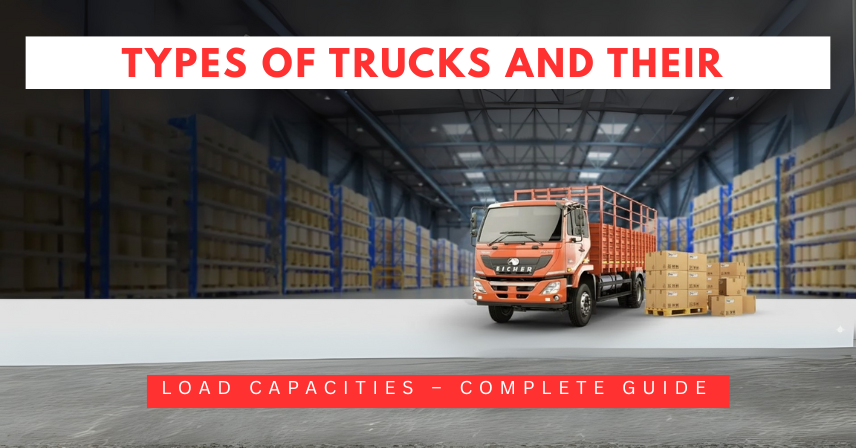Explore different types of trucks and their load capacities. From light-duty to heavy-duty trucks, discover detailed insights for businesses and logistics.
The trucking industry is the backbone of logistics, ensuring the smooth movement of goods across cities, states, and countries. From light-duty vehicles delivering groceries to heavy-duty trucks transporting industrial machinery, trucks play a vital role in supply chains.
However, not every truck is built the same. Each type is designed with specific load capacities, payload limits, and functions. Understanding the different types of trucks and their carrying capabilities is essential for businesses, fleet owners, and logistics professionals.
In this comprehensive guide, we’ll break down the types of trucks, their load capacities, and where they are best used.
Why Load Capacity Matters in Trucks
Before diving into the types, it’s crucial to understand truck load capacity. Load capacity refers to the maximum weight a truck can carry safely without risking damage to the vehicle or violating transport laws.
Load capacity is determined by several factors:
- Gross Vehicle Weight Rating (GVWR): Maximum total weight of the truck including cargo, fuel, and passengers.
- Axle Strength: Number of axles and their weight-bearing ability.
- Engine Power & Transmission: Determines towing and hauling efficiency.
- Chassis Design: Heavier frames can handle more load.
Selecting the right truck capacity ensures cost efficiency, safety, and compliance in logistics operations.
Main Types of Trucks and Their Load Capacities
1. Light-Duty Trucks
Light-duty trucks are commonly used for small deliveries, personal transport, and last-mile logistics.
Load Capacity: 0.5 to 3 tons
Examples: Pickup trucks, mini trucks, small cargo vans
Best For:
- Grocery deliveries
- E-commerce shipments
- Furniture and appliances
👉 Popular models include Tata Ace, Mahindra Bolero Pickup, and Ashok Leyland Dost in India.
2. Medium-Duty Trucks
Medium-duty trucks are the backbone of regional transportation. They balance fuel efficiency with moderate load-carrying ability.
Load Capacity: 3 to 10 tons
Examples: Box trucks, refrigerated trucks, flatbed trucks
Best For:
- FMCG distribution
- Refrigerated goods transport
- Regional courier and cargo
👉 Trucks like Eicher Pro 3015 and BharatBenz 1217C dominate this segment.
3. Heavy-Duty Trucks
Heavy-duty trucks are designed for industrial and commercial use, capable of carrying large payloads over long distances.
Load Capacity: 10 to 25 tons
Examples: Tractor-trailers, large dump trucks, tanker trucks
Best For:
- Steel and cement transport
- Construction materials
- Long-haul freight and logistics
👉 Examples include Tata Signa 4825.T, Volvo FMX, and Ashok Leyland 3718.
4. Extra-Heavy-Duty Trucks
These are specialized trucks built for massive loads and industrial projects.
Load Capacity: 25 to 45+ tons
Examples: Multi-axle trailers, oversized cargo trucks
Best For:
- Oil and gas equipment
- Mining machinery
- Oversized construction parts
👉 Trucks such as Scania R500 and Volvo FH16 handle these demanding loads.
5. Special-Purpose Trucks
These trucks are customized for unique operations and industries.
Examples & Capacities:
- Refrigerated Trucks (5–10 tons): For perishable goods.
- Cement Mixers (10–20 tons): For construction sites.
- Tow Trucks (5–15 tons): For vehicle recovery.
- Fire Trucks (10–20 tons): Equipped with water tanks and ladders.
👉 They are critical for specialized logistics and government services.
Truck Load Capacity Classification (Quick Reference Table)
| Truck Type | Load Capacity Range | Common Uses |
| Light-Duty Trucks | 0.5 – 3 tons | Local deliveries, e-commerce |
| Medium-Duty Trucks | 3 – 10 tons | FMCG, courier, refrigerated goods |
| Heavy-Duty Trucks | 10 – 25 tons | Construction, long-haul transport |
| Extra-Heavy-Duty Trucks | 25 – 45+ tons | Mining, oversized equipment |
| Special-Purpose Trucks | 5 – 20 tons (varies) | Specialized transport (fire, cement) |
Factors to Consider Before Choosing a Truck
- Type of Cargo: Fragile, perishable, or oversized cargo needs specific trucks.
- Distance & Terrain: Long-distance trucks require powerful engines and durability.
- Fuel Efficiency: Impacts cost-effectiveness in logistics.
- Regulatory Compliance: Trucks must adhere to GVW and axle load norms.
- Maintenance Costs: Larger trucks demand higher upkeep.
The Future of Trucking – EV & Smart Trucks
With sustainability becoming a priority, electric trucks and smart logistics vehicles are entering the market. Companies like Tata Motors, Volvo, and Tesla are investing heavily in EV trucks that offer:
- Lower emissions
- Reduced running costs
- Advanced telematics for fleet management
This shift will redefine truck load capacities and efficiency in the coming decade.
Conclusion
Trucks are not just vehicles; they are lifelines of trade and logistics. From light-duty to extra-heavy-duty trucks, each category serves a distinct purpose with specific load capacities. Choosing the right truck ensures safety, compliance, and efficiency for businesses.
As the industry moves toward electric and smart trucking, the future looks promising for logistics and fleet management.
👉 For more updates like this, visit www.commercialbhp.com

